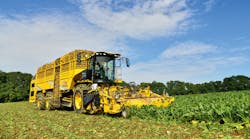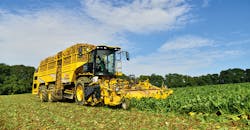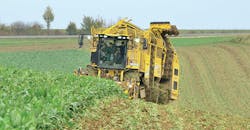Download this article in PDF format.
A combination of global market factors, both in agriculture and in biosciences, is growing opportunities for beet farmers. On the food side, beet sugar has grown to represent more than half of U.S. sugar production, while in parts of Canada, processing co-ops are creating new markets for both new and established beet farmers. Meanwhile, acreage devoted to sugar beets in the EU is expanding, putting the European market on the road to becoming a net exporter of sugar. On the commodities side, the growing world market for sustainable materials will lead to an increasing demand for beet pulp to be used for producing bio-plastics.
All this means that beets will be harvested in increasingly diverse environments—not just tropical climes, but also where temperature and growing conditions can vary widely. That requires harvesting equipment that can be equally productive under all environments—even where terrain is uneven, such as on hillside farms.
The Tiger 5 sugar beet harvester exemplifies the next generation of equipment to be put to work under such increasingly diverse conditions. This 15-meter-tall machine’s stepless drivetrain and hydraulics enable sure-footed operation, even on slopes. Its engine can perform at 617 hp with displacement of 15.6 l, and can propel it at up to 40 km per hour when empty. Under load it can support a curb weight of 33 tons, and a payload of more than 30 tons.
Two adjustable motors and a constant-speed motor work together to help this harvester achieve maximum traction force without losses.
To accommodate those hillsides, this three-axle beet harvester features stepless travel drive and automatic, hydraulic slope compensation (earning it “Machine of the Year 2015” in its category at the French SIMA trade fair for agricultural technology).
Stepless Gearbox: No Break in Traction
The 617 horsepower output by the engine is transferred by a stepless gearbox developed in a cooperative arrangement among Ropa GmbH, German manufacturers of beet and potato harvesters and other agricultural equipment; Omsi Transmissioni S.p.A in Italy; and Bosch Rexroth. Michael Gruber, sugar beet technology department manager at Ropa, notes that as early as four weeks after the kickoff meeting among these partners the draft concept for the drive was completed. The Constant Variable Ropa Gearbox (CVR) is comprised of three hydraulic motors located between the engine compartment and the third axle.
Key to its operation is the interaction of the two adjustable motors with a constant-speed motor. To achieve maximum traction force, all three motors work together when starting to move the machine. To increase the travel speed, the first adjustable motor is swiveled toward zero. Once it has reached zero, it has reached its velocity limit and is decoupled using a wet, multi-plate clutch. Since the motor is no longer being rotated, there are no losses. To increase travel speed even further, the second adjustable-speed motor is also swiveled toward zero, but remains coupled. Thus, at maximum travel speed, only the constant-speed motor is active in the drive train. Thanks to the larger slewing angle and the lower throughput losses, its efficiency is higher, thus saving fuel.
While the Tiger, during field work, is limited electronically to a maximum of 18 kilometers per hour, it can reach its top speed of 40 kph while on the road, traveling from field to field. This happens without shifting or interruptions in traction. At this speed the engine turns at a thrifty 1,195 rpm. In the field, it runs beginning at 1,100 rpm during harvesting. The developers wrote this low engine speed into the specifications to achieve lower consumption values.
Pushbutton control enables the machine to convert from on- to off-road. The unloading conveyor, the ring elevator, bunker augur, and other groups unfold in sequence—monitored by sensors and driven by hydraulic motors. This all takes half the time its predecessor required.
Stability and Consistency on Grades
This harvester’s hydraulic chassis system features an oscillating front axle and two rear axles with hydraulic suspension to reduce sway and increase stability on grades.
This machine also features a hydraulic chassis system with an oscillating front axle and two rear axles with hydraulic suspension. Unlike three-axle harvesters where the center axis is bolted to the frame, this machine’s tendency to sway is reduced by two-thirds. This is possible thanks to the hydraulically connected stabilization cylinders on the front and rear axles at each side. This also improves the way the harvester follows the rows and keeps penetration depth more uniform under variable conditions—even on difficult terrain. With six sensor-controlled hydraulic cylinders, the entire vehicle is tilted toward the slope by 10%—keeping it in the horizontal.
The compensation, effective in both directions, offers several advantages. Operation is more comfortable for the driver, since he always sits upright. And the vehicle itself is safer because even in extreme topography the machine avoids tipping over, despite the higher beet bunker. Beet farmers and harvesting contractors around the world will therefore find this new generation of beet harvesting equipment more efficient, less costly, and more productive to help them take advantage of the new but more demanding business opportunities coming their way.
Konrad Rossbach is with Bosch Rexroth AG, Germany. E-mail him at [email protected] or visit www.boschrexroth-us.com.




